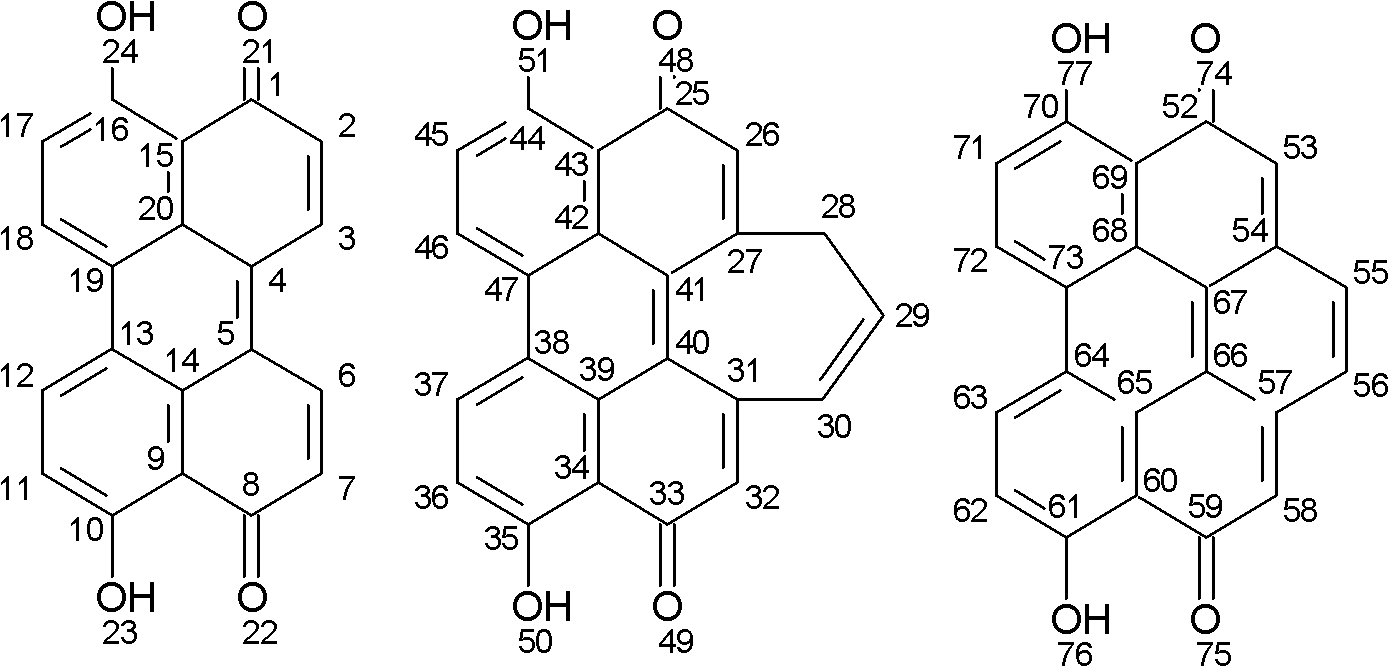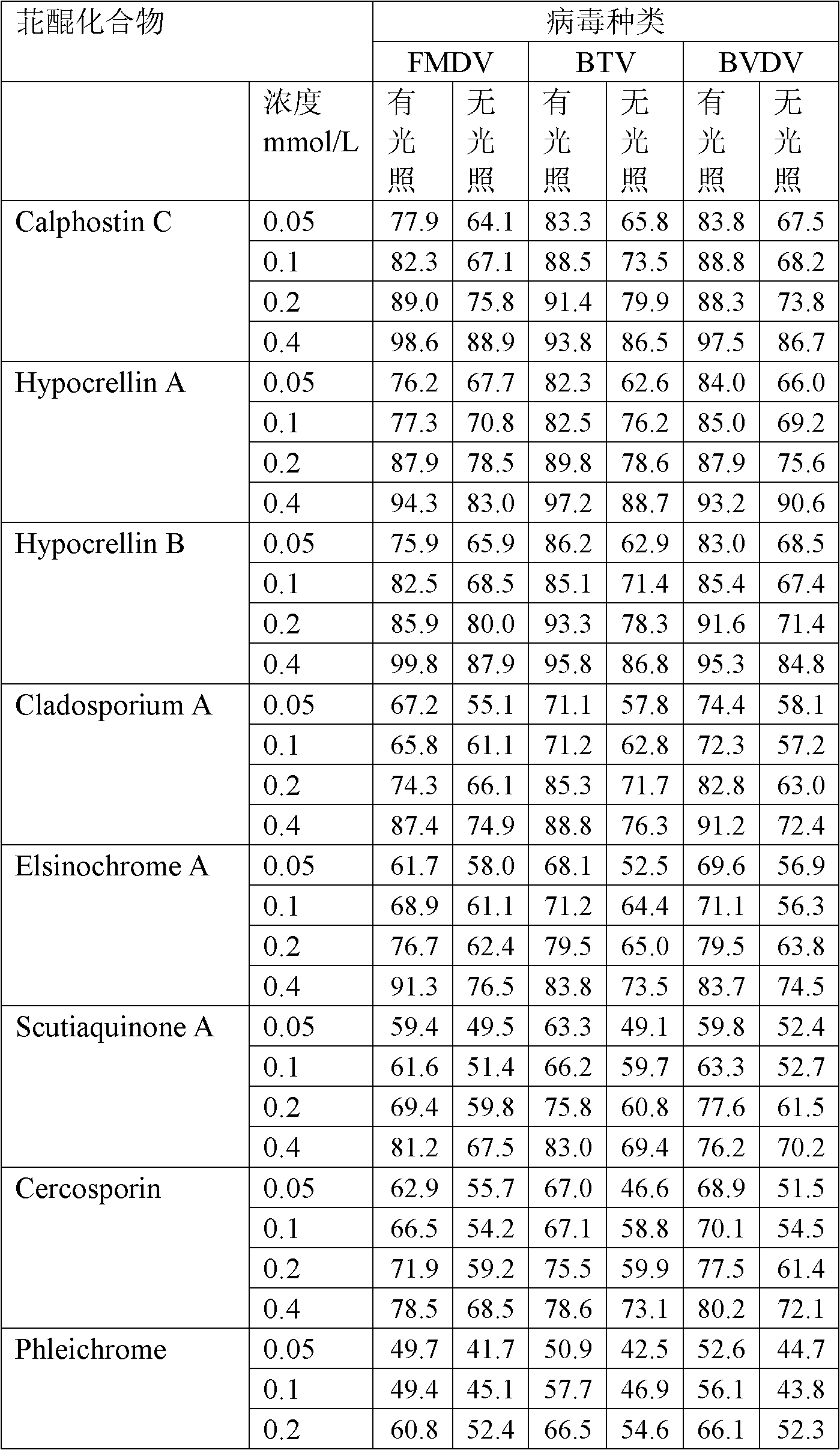Application of perylenequinone compound in preparation of feed for preventing and controlling ruminant viruses
A technology for ruminants and compounds, applied in animal feed, animal feed, applications, etc., can solve the problems that hypericin cannot be effectively used, easily decomposed, and the chemical properties of hypericin are unstable
- Summary
- Abstract
- Description
- Claims
- Application Information
AI Technical Summary
Problems solved by technology
Method used
Image
Examples
Embodiment 1
[0046] Example 1: In vitro antiviral experiment of perylenequinone compounds
[0047] (1) Preparation of cells for in vitro antiviral experiments
[0048] BHK-21 cells (Baby hamster kidney cells) were used to study the effect of perylenequinone compounds on foot-and-mouth disease virus (FMDV). Growth medium: buy MEM (modified eagle medium) medium, add NaHCO 3 2.0g / L, 2% fetal bovine serum, 1% penicillin, 1% streptomycin. After the BHK-21 cells were digested with 0.25% trypsin, the cells were dispersed by pipetting, and diluted with MEM growth medium to 1×10 6 Cells / mL, add to 96-well cell culture plate, 37°C, 5% CO 2 Cultured in an incubator, after the cells grew into a single layer of cells, the in vitro antiviral test was carried out.
[0049] The effect of perylenequinone compounds on bluetongue virus (BTV) was studied with Vero cells (African green monkey kidney cells, Verda Reno). Growth medium: add 110mg / L sodium pyruvate, 300mg / L L-glutamine, 200mg / L NaHCO to the p...
Embodiment 2
[0078] Embodiment 2: Anti-FMDV experiment of sheep added to feed by solid-state fermented hypocrellin
[0079] The basic diet formula of the sheep in the experiment was:
[0080] Concentrated feed formula: 46% corn, 20% bran, 30% cotton meal or rapeseed meal, 1% stone powder, 1% calcium hydrogen phosphate, 1% salt, 1% premix (which can provide vitamin A 1200IU per kg feed , Vitamin D 32500IU, Vitamin E 30IU, Vitamin K 3mg, Riboflavin 4mg, Niacin 40mg, Pantothenic Acid 15mg, Choline Chloride 400mg. Folic Acid 700g, Thiamine VB 1.5mg, Vitamin B 3mg, Biotin 100g, Zn 80mg, Mn 20mg, Fe 83mg, Cu 25mg), particle size 1-2mm. In the final diet of sheep: grass hay accounts for 45%, silage corn 23%, and concentrate 32%.
[0081] Hypocretin is produced by solid-state fermentation, corn is the main raw material, and 2% glucose and 0.2% KH based on the weight of corn are added 2 PO 4 , 0.04% MgSO 4 ·7H 2 O. Add water and mix the material to make it wet, control the ratio of material ...
Embodiment 3
[0093] Example 3: Anti-bovine BVDV virus experiment of liquid fermented hypocretin added to feed
[0094] Experimental basic diet: corn 48%, bran 14%, cottonseed cake 35%, stone powder 1.0%, bone meal 0.5%, salt 1.0%, sodium bicarbonate 0.5%.
[0095]Hypocretin is produced by liquid fermentation method, and the culture medium per liter consists of: glucose 20g, peptone 50g, potato 200g, (NH 4 ) 2 HPO 4 2g, KH 2 PO 4 2g, MgSO 4 0.5g / L, sterilized at 121°C for 20min, then add 10% liquid bamboo yellow fungus seeds after cooling. Both the initial pH and the pH of the fermentation process are natural, the fermentation temperature is 30° C., and the fermentation ends in 72 hours. The fermented liquid was removed by centrifugation to obtain mycelium, which was dried at 60°C. It was determined that hypocrellin A accounted for 8.1%, hypocrellin B accounted for 1.3%, and the total amount of other perylenequinone compounds accounted for 0.2%.
[0096] Forty calves with an average ...
PUM
 Login to View More
Login to View More Abstract
Description
Claims
Application Information
 Login to View More
Login to View More - R&D
- Intellectual Property
- Life Sciences
- Materials
- Tech Scout
- Unparalleled Data Quality
- Higher Quality Content
- 60% Fewer Hallucinations
Browse by: Latest US Patents, China's latest patents, Technical Efficacy Thesaurus, Application Domain, Technology Topic, Popular Technical Reports.
© 2025 PatSnap. All rights reserved.Legal|Privacy policy|Modern Slavery Act Transparency Statement|Sitemap|About US| Contact US: help@patsnap.com



